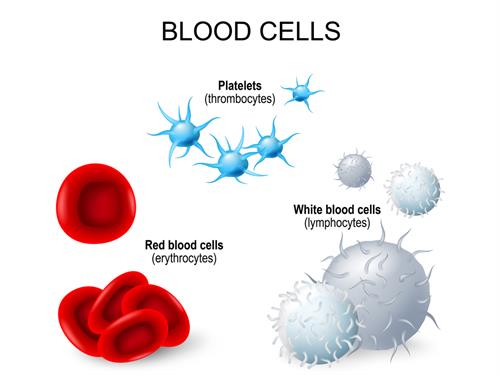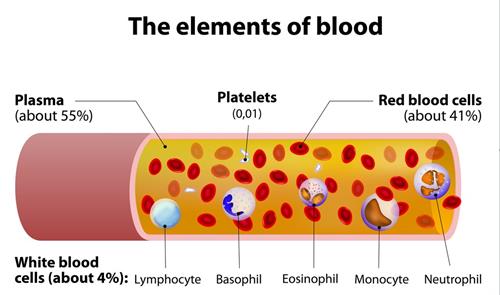PDF chapter test TRY NOW
The lymph and the blood are the fluid connective tissues, and they connect different parts of the body. The cells present in the tissues are loosely spaced and are embedded in an intercellular matrix.
What are the main characteristics of connective tissue?
- It arises from the mesoderm of the embryo.
- It has elements such as matrix, fibres and cells.
There is a connective tissue that is in the form of fluid and has the above-mentioned characteristics.
- It also arises from the mesoderm of the embryo.
- It has a non-living fluid matrix called plasma.
- It has soluble protein molecules as fibres.
- It also has different types of cells.
Hence this tissue is called fluid connective tissue. We call it 'blood'.
Blood:
It is a fluid connective tissue that connects various parts of the body. It helps to maintain the continuity of the body. Blood contains corpuscles like RBCs (Red blood corpuscles), WBCs (White blood corpuscles) and platelets suspended in it.

Types of blood cells
Blood cells move into the liquid matrix called plasma. It is a pale yellow colour fluid. Blood plasma contains inorganic salts and organic and inorganic substances such as electrolytes, nutrients, proteins, hormones and enzymes.

Blood and its components
Function:
- Blood transports nutritive materials, gases, vitamins and hormones to tissues present all around the body.
- It carries waste products from tissues to excretory organs like the liver and kidney.
- It also conducts heat and maintain the body temperature.
Red blood corpuscles:
- The blood cell contains a respiratory pigment called haemoglobin; due to that, blood looks red. The pigment is involved in the transport of oxygen to tissues.
- The life span of RBC is 120 days.
- Mature RBC do not contain a nucleus.
- Most of the cell organelles like mitochondria and lysosomes are absent in these cells.
- The shape of the RBC is an oval-shaped, circular biconcave disc-like.
- Red blood cells, also termed as erythrocytes.
Function: It plays a critical role in transporting gases such as oxygen from the lungs. They also aid in carbon dioxide transport from tissues to the lungs.
Do you know:
- In humans, RBCs are smaller than WBCs. RBCs are 7.2 µm in diameter.
- Per cubic mm of blood contains about 5.5 and 4.5 million RBCs for a normal adult man and woman, respectively.
- A decrease in RBC count results in a condition called anaemia.
- An increase in RBC count results in a condition called polycythemia.
White blood-corpuscles:
- It is colourless.
- WBC have an irregular shape. Hence they have a capable of amoeboid movement.
- The life span of WBC is 13 to 20 days.
- It is also called Leucocytes.
- They contain nucleus and cell organelles like ER, golgi apparatus and mitochondria.

White blood cells
Function: White blood cells play a major role in the defence mechanism, helping the body fight against disease-causing pathogens by producing antibodies.
Leucocytes are of two types:
- Granulocytes (with granules in the cytoplasm)
- Agranulocytes (without granules in the cytoplasm)
Granulocytes: They have irregularly shaped nuclei and small cytoplasmic granules. The specific types of granulocytes are basophils, neutrophils and eosinophils.
Agranulocytes: They do not have distinct cytoplasmic granules. The specific types of agranulocytes are lymphocytes and monocytes. Lymphocytes have a spherical nucleus, and the monocytes have a large nucleus indented on one side.
Function: They engulf or destroy foreign pathogenic particle and neutralise their harmful effects.
Note:
Do you know!
- A decrease in WBC count in the blood creates a condition called leukopenia.
- An increase in WBC count in the blood creates a condition called leukaemia (cancer of the blood).
- Monocytes are the largest cell of white blood cell, while lymphocytes are the smallest.
Blood platelets:
Have you noticed that whenever an injury happens, there may be bleeding (outflow of blood) but eventually stop at a certain point, the bleeding stops?
This process of stopping blood outflow is known as blood clotting and is due to blood platelets or thrombocytes.
- Platelets are tiny, anucleated, blood cells.
- Per cubic mm of blood contains 2-2.5 lakhs of blood platelets.
- These cells are plating a vital role in the blood clotting mechanism.
- The life span is about 8-10 days.

Platelet structure
Mechanism of blood clotting:
\huge{\downarrow}
Prothrombin activator converts prothrombin to thrombin.
\huge{\downarrow}
Thrombin, in turn, converts fibrinogen into fibrin.
\huge{\downarrow}
Fibrin forms a mesh-like structure that traps red blood cells.
\huge{\downarrow}
The bleeding stops when a clot forms.
Note:
- A decrease in circulating blood platelets count results in a condition called thrombocytopenia.
- Haemophilia is a condition where the thrombocytes is absent in a persons blood. Haemophiliacs (person affected by this disorder) must be extremely careful not to sustain bleeding wounds as they can bleed themselves to death.
Lymph - a white connective tissue:
- It is a colourless fluid filtered out of the blood capillaries.
- It contains plasma and white blood cells (mostly lymphocytes).
- It is a tissue that lack of red corpuscles, platelets and proteins.
- It also has less phosphorus and calcium than the blood.
- It can clot like blood.
Video explaining about the lymphatic system
- Lymph mainly helps in the exchange of materials between blood and tissue fluids.
- It also helps to destroy the invasion of pathogens.
